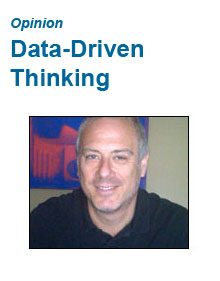 “Data-Driven Thinking” is a column written by members of the media community and containing fresh ideas on the digital revolution in media.
“Data-Driven Thinking” is a column written by members of the media community and containing fresh ideas on the digital revolution in media.
Today’s column is written by Alan Pearlstein, CEO at Cross Pixel Media.
It is easy to understand the role a brand can play in determining the value of media. Assuming all things are equal, an ad that appears on the NYTimes.com will almost always outperform the same ad targeting the exact same audience on a generic site like a forum or music lyrics site. In general the advertiser will benefit from the association with the premium publisher and more readers will react positively to the advertising.
I believe that brands can also play a role in determining the value of online data. If you understand the brand that is the source of the data, you can glean a wealth of information about the data that will lead to greater performance. For example, consumers that shop at Saks Fifth Avenue are a completely different data set than consumers that shop at Kohls. If you were marketing moderately priced apparel, their would be a significant benefit in knowing the source of the retailer that was supplying the data in this campaign. When you know the source of the data you can understand the demographics, psychographics and brand affinities of the audience you are targeting. Knowing the brand behind the data enables a marketer to align themselves with similarly situated brands and drive greater performance.
Terence Kawaja in his IAB presentation commented that data is already becoming commoditized. I tend to agree with him and the problem isn’t just an advertiser’s issue. I think the data suppliers and aggregators will be hurt in the long run if they can’t distinguish their data from another supplier’s data. And as data aggregators and exchanges mix data sources into the same buckets, they are hurting some high value data by mixing it with average data, and vice versa. If you are a data owner, you may end up losing many data sales because the overall campaign doesn’t perform, even though the impressions that were exposed to your data may have performed very well.
I view customer acquisition and demand generation as both a science and an art. It is understandable that our data driven ecosystem has focused entirely on the science to this point. In a RTB world, we need to rely on algorithms to make a magnitude of decisions on the fly, and the focus has been on building the technology and platforms to make that happen. I think Greg Hills is correct– the algorithm is the new decision maker. However, I wonder if…
-
a) the algorithms are taking brand factors into account properly when making decisions and…
b) if they are, would this role be better served by people?
I think the answer to b is yes, sometimes. For example, if your target audience is high-end apparel shoppers that live in the cities and affluent suburbs, you could do a lot of testing, ad spending, and optimization to identify and aggregate this audience data using an algorithm. Or, you could find this target by using data from a brand that caters to this target audience – a high-end apparel retailer that is based in the cities or suburbs such as Saks or Neiman Marcus.
Sometimes human beings can outperform algorithms and while we are in a technology-driven business, we should keep this point in mind. A review of the search results on Google for most commercial goods shows that the paid results that are controlled by people are usually a better set of results than the organic results that are driven by Google’s algorithm.
A brand carries valuable information about the data source that can benefit advertisers and data owners. Whether it is executed by computers or managed by people, I believe we need to factor in the value of each brand when making data buying decisiosn because the advertisers will get a better ROI and data owners will get fair market value for their data, rewarding the top brands appropriately.
Follow Alan Pearlstein (@AlanPearlstein) and AdExchanger.com (@adexchanger) on Twitter.










